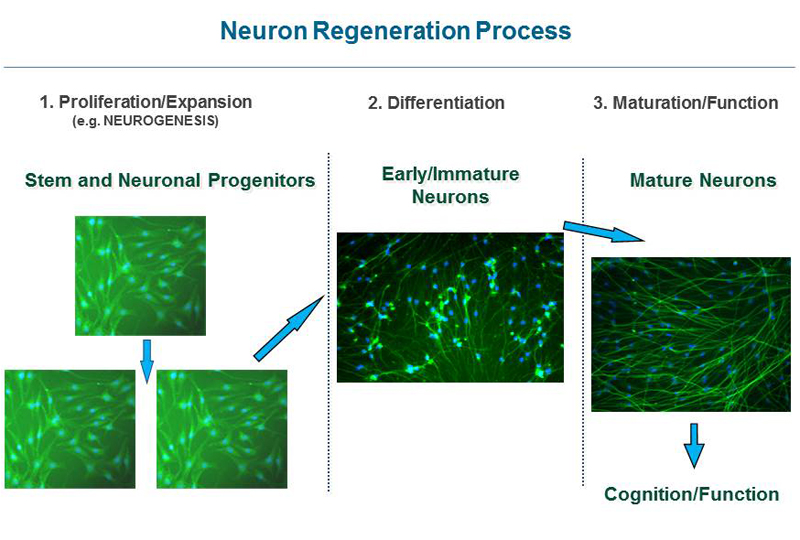Neurogenesis & Neuron Regeneration
New neurons form in the brain from neuronal progenitor cells well into adulthood, but only in two distinct regions of the brain. The hippocampus, an area critical for learning and memory, and the subventricular zone each have a significant neuronal progenitor cell niche. For a neuronal progenitor cell to transform into a mature and functioning neuron involves a number of steps (see figure below). The first step of this multi-step process involves the proliferation of the neuronal progenitor cells, which is often referred to as “Neurogenesis”. The nascent progenitors need to then migrate and differentiate into early neurons. These early neurons then must reach maturity and become functional in the brain circuitry. Changes in the rate and outcome of each step due to aging, stress, injury and disease can ultimately affect brain functions. Under conditions of chronic
neurodegeneration and aging, replacement of neurons through this multi-step process is called “Neuron Regeneration”.
Why are neurogenesis and neuron regeneration exciting targets for therapeutic intervention in a number of neurological disease indications?
One rule of thumb is that the human body attempts to conserve energy-consuming processes, like the production of new neurons in the hippocampus. Therefore, the brain must “require” and “utilize” these nascent neurons for cognitive benefit and maintenance. Additionally, the literature suggests that under a number of chronic neurodegenerative conditions (reviewed in Kelleher-Andersson 2006), the brain attempts to compensate for neuron loss by promoting proliferation and migration/differentiation to those regions of the brain selectively damaged by neurodegeneration.
In this way, neuron loss in many regions of the brain could be minimized through proliferation and migration of progenitors from the two progenitor sites, though this compensation may not be sufficient under chronic neurodegeneration (i.e. Alzheimer’s disease). By discovering oral therapies that further advance neuron regeneration, it should be possible to halt and potentially reverse chronic neurological disease and even aging progression.
A greater rate of neurogenesis, in the absence of chronic neurodegeneration, can be a path to major improvements in hippocampal brain function and capacity. Particularly, a neurogenesis-inducing agent could be beneficial under conditions where new progenitor formation has slowed, as seen in major depressive disorders and developmental delay, in Down syndrome individuals. Neuronascent’s scientists have discovered therapeutics that enhance neurogenesis and neuron regeneration in models of disease, and this brain morphological change correlates with significant behavioral benefit. The means by which these therapeutic candidates were identified by Neuronascent is described elsewhere (Drug Discovery).

